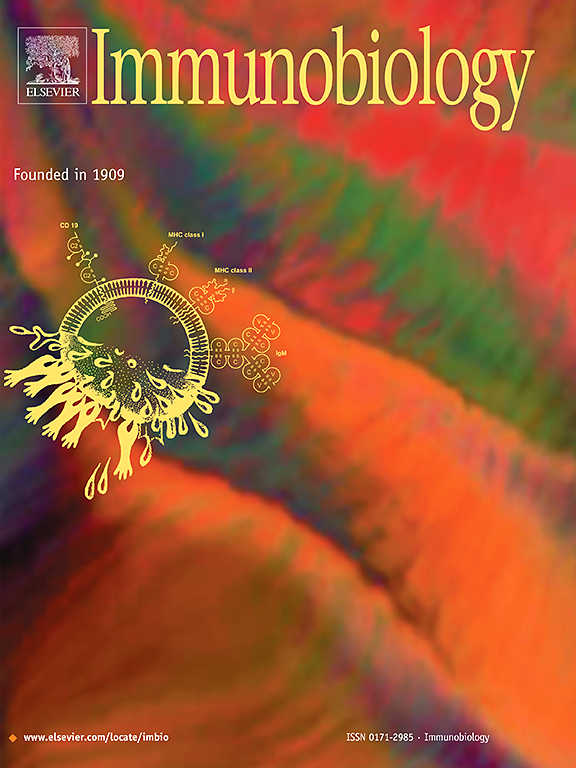Biomarker identification for rheumatoid arthritis with inadequate response to DMARD and TNF therapies using multidimensional analyses
IF 2.3
4区 医学
Q3 IMMUNOLOGY
引用次数: 0
Abstract
Purpose
Rheumatoid arthritis (RA) is an immune system disorder disease accompanied with severe joint damage. However, the molecular mechanism of RA with insensitive to medicine remains insufficient. Thus, this study aims to identify the biomarkers of RA patients with inadequate responses (IR) toward disease-modifying antirheumatic drug (DMARD) and antitumor necrosis factor (TNF) therapies, using multidimensional analyses.
Methods
Gene expression data GSE45291 originating from clinics were downloaded from the Gene Expression Omnibus public database (GEO). Differentially expressed genes (DEGs) closely associated with DMARD&TNF-IR RA were identified using the Limma R package. Weighted gene co-expression network analysis (WGCNA) was carried out to identify critical genes. The CIBERSORT algorithm and single sample Gene Set Enrichment Analysis (ssGSEA) were employed for immune infiltration analysis and functional enrichment analysis, respectively. Lastly, mRNA expression levels of the identified hub genes in inflammatory conditions of collagen-induced arthritis (CIA) rats and lipopolysaccharide (LPS)-induced RAW264.7 cells were further observed using RT-qPCR.
Results
In this work, a total of 17 genes were identified as hub genes. Of these, the expression levels of UHMK1, ELK4, APOC2, and SFT2D1 were significantly lowered in inflammatory conditions. GSEA indicated B cells with the immune-related genes play an essential role in the course of DMARD&TNF-IR RA. Notable differences in immune cell proportions (activated. Dendritic. cell, CD56 bright. Natural. killer. Cell, gamma. Delta. T. cell, MDSC, macrophage) were observed between normal and disease groups, suggesting immune involvement.
Conclusion
The findings of this study provide additional understanding of the detection of DMARD&TNF-IR RA.
类风湿性关节炎对DMARD和TNF治疗反应不足的生物标志物鉴定使用多维分析
目的类风湿性关节炎(RA)是一种伴严重关节损伤的免疫系统紊乱疾病。然而,药物不敏感类风湿性关节炎的分子机制尚不清楚。因此,本研究旨在通过多维分析,确定对改善疾病的抗风湿药物(DMARD)和抗肿瘤坏死因子(TNF)治疗反应不足(IR)的RA患者的生物标志物。方法从基因表达综合公共数据库(Gene expression Omnibus public database, GEO)下载临床基因表达数据GSE45291。差异表达基因(DEGs)与DMARD&;TNF-IR RA密切相关,使用Limma R包进行鉴定。采用加权基因共表达网络分析(Weighted gene co-expression network analysis, WGCNA)鉴定关键基因。免疫浸润分析采用CIBERSORT算法,功能富集分析采用单样本基因集富集分析(ssGSEA)。最后,利用RT-qPCR进一步观察胶原诱导关节炎(CIA)大鼠和脂多糖(LPS)诱导的RAW264.7细胞炎症状态下所鉴定的枢纽基因的mRNA表达水平。结果共鉴定出17个中心基因。其中,UHMK1、ELK4、APOC2和SFT2D1的表达水平在炎症条件下显著降低。GSEA表明,具有免疫相关基因的B细胞在DMARD&;TNF-IR RA过程中起重要作用。免疫细胞比例(激活)的显著差异。树突。细胞,CD56亮。自然。杀手。细胞,γ。三角洲。t细胞,MDSC,巨噬细胞)在正常组和疾病组之间观察到,提示免疫参与。结论本研究的发现为DMARD&;TNF-IR RA的检测提供了额外的理解。
本文章由计算机程序翻译,如有差异,请以英文原文为准。
求助全文
约1分钟内获得全文
求助全文
来源期刊

Immunobiology
医学-免疫学
CiteScore
5.00
自引率
3.60%
发文量
108
审稿时长
55 days
期刊介绍:
Immunobiology is a peer-reviewed journal that publishes highly innovative research approaches for a wide range of immunological subjects, including
• Innate Immunity,
• Adaptive Immunity,
• Complement Biology,
• Macrophage and Dendritic Cell Biology,
• Parasite Immunology,
• Tumour Immunology,
• Clinical Immunology,
• Immunogenetics,
• Immunotherapy and
• Immunopathology of infectious, allergic and autoimmune disease.
 求助内容:
求助内容: 应助结果提醒方式:
应助结果提醒方式:


